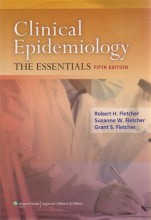Summary: Users' Guides To The Medical Literature A Manual For Evidence-Based Clinical Practice... | 9780071590358 | Gordon Guyatt, et al
- This + 400k other summaries
- A unique study and practice tool
- Never study anything twice again
- Get the grades you hope for
- 100% sure, 100% understanding
Read the summary and the most important questions on Users' Guides to the Medical Literature A Manual for Evidence-Based Clinical Practice, Second Edition | 9780071590358 | Gordon Guyatt; Drummond Rennie; Maureen O. Meade; Deborah J. Cook
-
13.4 surrogate outcomes
This is a preview. There are 4 more flashcards available for chapter 13.4
Show more cards here -
What are surrogate endpoints?
Physiological or functional variables, that substitute for direct measures of patient important outcomes.
Often used because they are: earlier measurable, more easily, more frequently, with higher precision, or with less confounding. -
16 The Process of diagnosis
This is a preview. There are 1 more flashcards available for chapter 16
Show more cards here -
What kind of differential diagnosis lists are there?
- possibilistic list: all are equally likely and tested for simultaneously
- probabilistic list: the more likely diso (more experience clinicians)
- prognostic list: the diso more serious if left undiagnosed
- pragmatic list: the diso more responsive to treatment -
How to estimate pretest possibilities?
- clinician's intuition (however subject to bias and random error)
- use evidence e.g. Clinical dicision rules of prediction rules
note: the sum of all probabilities should equal 1 -
What determines the test and treatment tresholds?
A combination of the follwing:
- the properties of a test (safety, acceptability, costs)
- the disease prognosis (what if undiagnosed)
- nature of the treatment (effectiveness, harm, availability) -
17 differential diagnosis
-
Use evidence in estimating probs for diff diagnosis;How to judge the risk of bias?
1. representation of the study patientscleardefinition of clinical problem- relevant settings
- consecutive recruitment of
selectio - spectrum of severity and clinical features
2. definitive diagnosis?suffuciently comprehensive?- consistently applied to all patients?
- were criteria explicit and credible?
- is it reproducible?
- fraction
undiagnoses ? - when
undiagnosed : was follow upsufficiently long and complete?
-
Use of evidence; how to judge the results?
3. What were the diagnosis and theirprobs ?- sometimes more causes/
coexisting diseases
4. How precise are the estimates?- relation to test and treatment
treshold
- sometimes more causes/
-
Use of evidence; How to determine the applicability of the results?
5. Are the study patients and clinical setting similar?
6. Is it unlikely that the disease probs have chanched since this evidence was gathered? -
18 diagnostic tests
This is a preview. There are 7 more flashcards available for chapter 18
Show more cards here -
What are important factors to assess the risk of bias?
- representative sample (if not representative-> spectrum bias)
-comparison to an appropriate and independent reference standard
- blinding of investigators taking tests and interpreters
- completion of data; did all took index- and refencetest (if not-> verification or work-up bias).- Specific group didn't take the reference test -> partial verification bias
- different reference tests are used -> differential verification bias
-
What are important factors to assess the results?
- with a range of possible test results:
knowlegde of the likelihood ratio (multilevel LR)
use of a nomogram or converting to odds in order to calculate the posttest probability
- dichotomize continuous testscores in order to construct a 2x2 table
allowing:- calculation of sensitiviteit: TP/ number of disease present
- calculation of specificiteit: TN/ number of disease absent
- calculate LR+ (positive testresult) LR- (negative testresult)
- LR+ = TP rate (a/a+c) divided by FP rate (b/b+d)
- LR- = TN rate/ FN rate
use the calculated LR's using the 2x2 table -
What is a likelihood ratio?
The property of a test; which address the direction and magnitude of the change in pretest pobs to post test probs
- Higher grades + faster learning
- Never study anything twice
- 100% sure, 100% understanding
































